标签:sign 安全 standard 支持 ring 场景 开发 长度 stdio.h
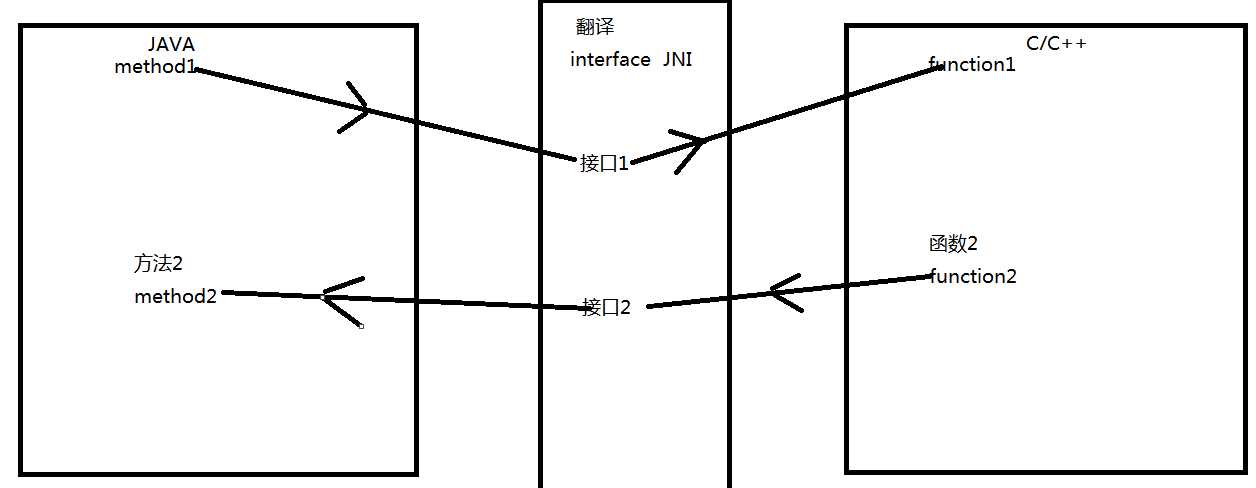
#include<stdlib.h> 相当于java import .h c的头文件 std standard 标准的 lib library 标准函数库#include<stdio.h> standard io 标准输入输出流 相当于 java.lang main(){ //c程序的入口 public static void main(String ars[]) printf("hello world!\n");//向控制台输出一句话 system.out.print "\n"换行符 system("notepad"); system("calc"); system("pause"); //system调用系统底层的命令 在当前的这个程序中 调用windows命令 }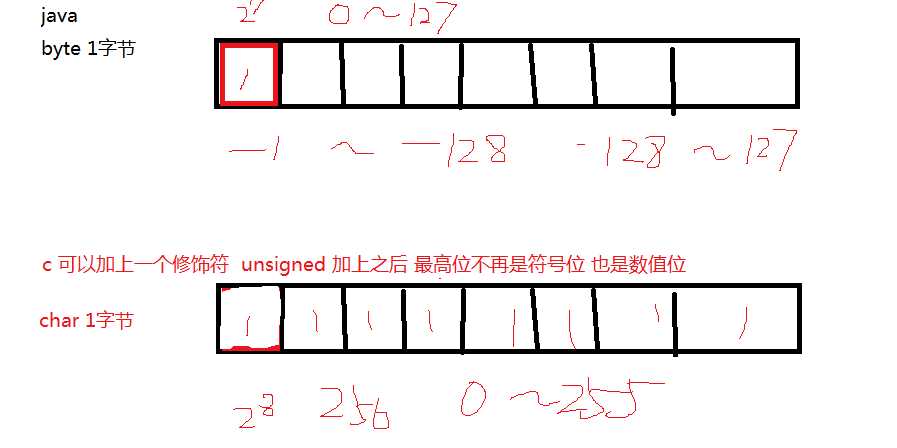
#include<stdlib.h>#include<stdio.h>/*输出函数 printf("要输出的内容+占位符",.......)常用占位符%d - int%ld – long int%lld - long long%hd – 短整型 short 2字节 %c - char%f - float%lf – double%u – 无符号数%x – 十六进制输出 int 或者long int 或者short int%o - 八进制输出%s – 字符串*/// 12345678 10111100 01100001 01001110 //24910 1100001 01001110 main(){ int i = 12345678; char c = ‘a‘; short s = 1234; long l = 12345678; float f = 3.14; double d = 3.1415926; printf("int i = %d\n",i); printf("char c = %c\n",c); printf("short s = %hd\n",s); printf("long l = %ld\n",l); printf("float f = %.2f\n",f);//printf输出小数会截取6位有效数字 不足6位补0 超过6为四舍五入 printf("double d = %.7lf\n",d); // &.2f保留两位有效数字 printf("int i = %#x\n",i); // %#x %#o 可以给16进制输出和8进制输出添加前缀 printf("int i = %#o\n",i); //java 字符串 String //c字符串实际就是一个字符数组 char //c数组的声明 和java的区别 c的数组不检测越界 表示字符串的结束 \0 char array[] = {‘a‘,‘b‘,‘c‘,‘d‘,‘\0‘}; printf("c的字符串array=%s\n",array); char array2[] = "你好"; printf("array2=%s\n",array2); system("pause"); }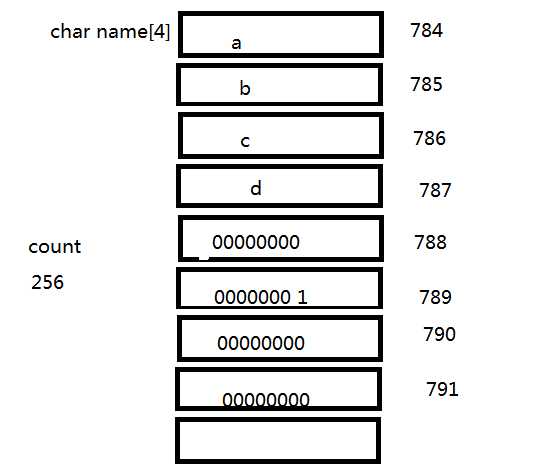
#include<stdlib.h>#include<stdio.h>/*输入函数 ScanfInt len;Scanf(“%d”,&len); &取地址符号数组不检测越界 */main(){ printf("请输入班级的人数:"); int count; scanf("%d",&count); //取出count的地址 用户的输入就会保存到count这个变量中 printf("班级人数为%d\n",count); char name[4]; printf("cound的地址%d,name的地址%d\n",&count,&name); printf("请输入班级的名字:"); scanf("%s",&name); printf("班级的人数%d,班级的名字%s",count,name); system("pause"); }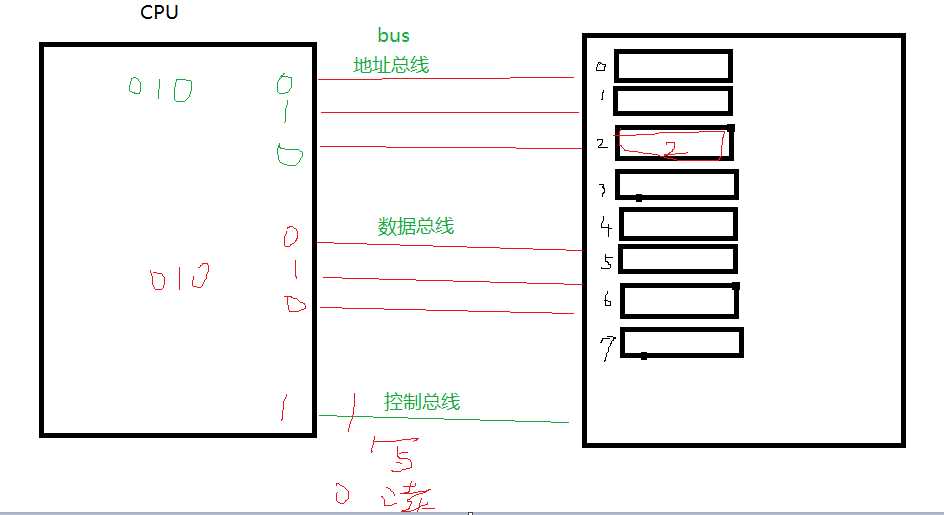
#include<stdlib.h>#include<stdio.h>// 变量的类型 * 变量名// int* p pointer int* p int * p int *p//由于把i的地址保存到了指针变量p中 *p 等价于 i main(){ int i = 123; //p就是一个指针变量 int* p = &i; printf("*p = %d\n",*p); *p = 456; printf("i = %d\n",i); system("pause"); }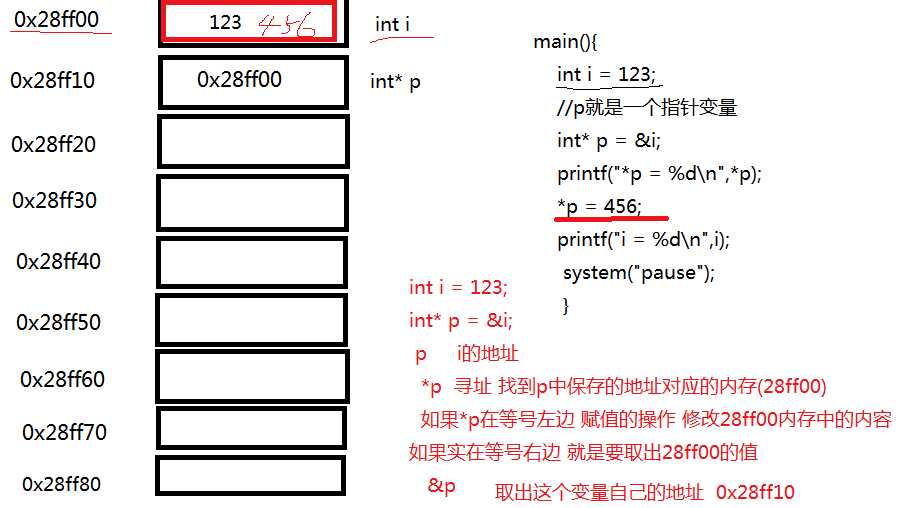
#include<stdlib.h>#include<stdio.h>main(){ //java如果声明一个变量 如果是基本数据类型会帮助你初始化 //①野指针 指针变量声明之后没有初始化 直接通过*p= 做赋值操作 就叫野指针 //避免野指针 //②指针的类型和保存的地址类型要匹配 int类型的指针要指向int类型的地址 //double类型的指针 要保存一个double类型的变量地址 //int i; double i = 123.4567; int* p = &i; printf("p = %#x\n",p); *p = 1234; printf("i = %lf\n",i); system("pause"); }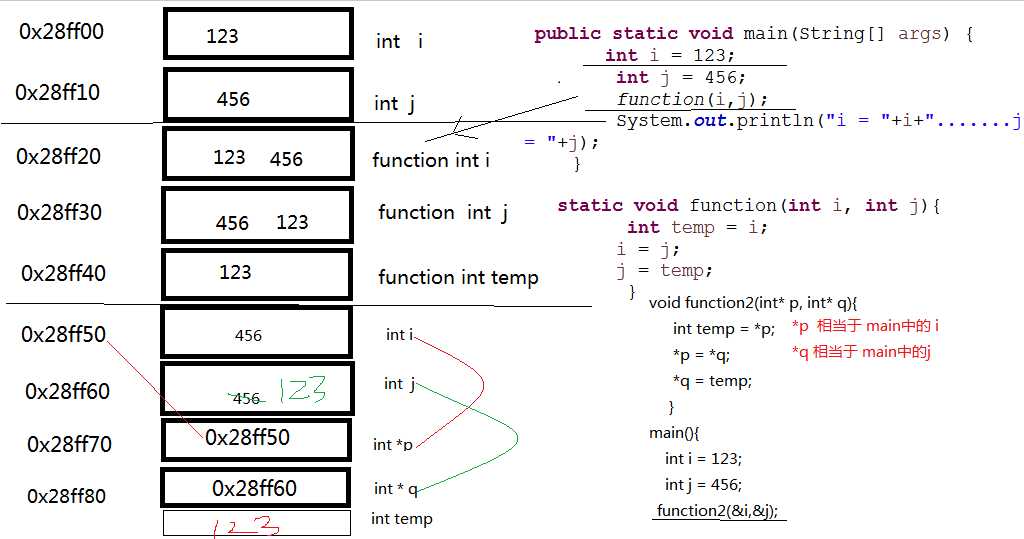
#include<stdlib.h>#include<stdio.h>void function(int* p ,int *q){ *p *= 2; *q *= 2; }main(){ int i = 123; int j = 456; function(&i,&j); printf("i = %d\n",i); printf("j = %d\n",j); system("pause"); }#include<stdlib.h>#include<stdio.h>//①数组占用一块连续的内存空间 //② 数组的名字的地址实际上就是数组的第一个元素的地址 就是数组的首地址// ③ 通过指针变量指向数组的第一个元素的地址 就可以访问到其余元素 访问的方式就是通过指针的位移运算 +1 +2//跟通过索引访问数组是一样的//④ 通过指针位移的方式访问数组需要注意 指针每+1 究竟移动几个字节跟 指针变量的类型有关 //int* p p+1移动4个字节 char* p p+1移动1个字节 main(){ // char array[] = {‘a‘,‘b‘,‘c‘,‘d‘,‘\0‘}; int array[] = {1,2,3,4}; printf("array[0]的地址是%#x\n",&array[0]); printf("array[1]的地址是%#x\n",&array[1]); printf("array[2]的地址是%#x\n",&array[2]); printf("array[3]的地址是%#x\n",&array[3]); printf("array的地址是%#x\n",&array); //数组变量名的地址实际上就是数组的首地址(第一个元素的地址) char* p = &array[0]; //int* p = &array; // p = &array; printf("p = %#x\n",p); printf("p+1 = %#x\n",p+1); printf("p+2 = %#x\n",p+2); printf("p+3 = %#x\n",p+3); /* printf("*(p+0)= %c\n",*(p+0)); printf("*(p+1)= %c\n",*(p+1)); printf("*(p+2)= %c\n",*(p+2)); printf("*(p+3)= %c\n",*(p+3)); */ printf("*(p+0)= %d\n",*(p+0)); printf("*(p+1)= %d\n",*(p+1)); printf("*(p+2)= %d\n",*(p+2)); printf("*(p+3)= %d\n",*(p+3)); printf("*(p+4)= %d\n",*(p+4)); system("pause"); }#include<stdlib.h>#include<stdio.h>main(){ char str[] = {‘a‘,‘b‘,‘c‘,‘d‘,‘\0‘}; char str1[] = "你好"; printf("str的地址= %#x\n",str); printf("str的地址= %#x\n",&str); char* str2 = str; //c定义字符串最常用的方式 char * str = "hello"; char* str3 = "你好"; printf("str3 = %s\n",str3); system("pause"); }#include<stdlib.h>#include<stdio.h>//32位环境下(硬件环境 操作系统环境 编译器的环境) 所有的指针变量 不管什么类型都占4个字节 //地址线 32位 2^32 1byte 2^8 4个字节 刚好可以表示32位的二进制数 //64位环境 指针变量长度 8字节 main(){ char* p ; int * p1; double* p2; printf("char类型指针占%d个字节\n",sizeof(p)); printf("int类型指针占%d个字节\n",sizeof(p1)); printf("double类型指针占%d个字节\n",sizeof(p2)); system("pause"); }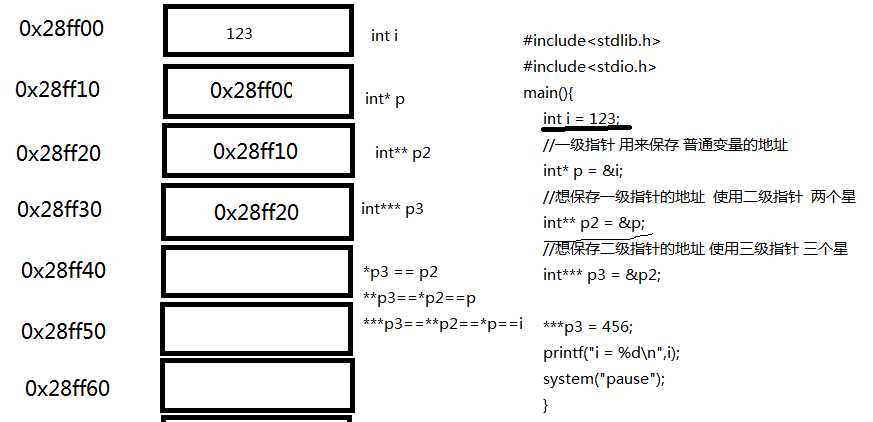
#include<stdlib.h>#include<stdio.h>main(){ int i = 123; //一级指针 用来保存 普通变量的地址 int* p = &i; //想保存一级指针的地址 使用二级指针 两个星 int** p2 = &p; //想保存二级指针的地址 使用三级指针 三个星 int*** p3 = &p2; ***p3 = 456; printf("i = %d\n",i); system("pause"); }#include<stdlib.h>#include<stdio.h>//main函数获取子函数中临时变量的地址 子函数要修改mian函数中临时变量的值 void function(int** q){ int i = 123; *q = &i; printf("i的地址%#x\n", &i); }main(){//声明一个一级指针用来保存地址 int* p; function(&p); printf("p的值%#x\n", p); system("pause"); }#include<stdlib.h>#include<stdio.h>//java的数组 int array[] = new int[]{}; java的数组都在堆中//c的数组可以在栈里 int* function1(){ int array[] = {1,2,3,4,5}; printf("array的地址%#x\n",&array); return &array; } int* function2(){ int array1[] = {5,4,3,2,1}; printf("array1的地址%#x\n",&array1); return &array1; }main(){ int* p = function1(); function2(); printf("*(p+0)=%d,*(p+1)=%d,*(p+2)=%d\n",*(p+0),*(p+1),*(p+2)); printf("*(p+0)=%d,*(p+1)=%d,*(p+2)=%d\n",*(p+0),*(p+1),*(p+2)); system("pause"); }#include<stdlib.h>#include<stdio.h>//动态内存分配 操作的是堆内存(heap ) 堆内存 大小跟机器运行程序时的状态有关 //java申请堆内存 new //c申请堆内存 malloc(堆内存的大小) 返回值 申请到的堆内存的首地址 memory allocation 内存分配 //C申请的堆内存需要手动释放 free(p) 传入的参数就是malloc的返回值 main(){ int* p = malloc(sizeof(int)*5); //for循环c当中需要先声明变量 不能在for()直接声明 int i; for(i = 0;i<5;i++){ *(p+i) = i; } printf("*(p+0)=%d\n",*(p+0)); printf("*(p+1)=%d\n",*(p+1)); printf("*(p+2)=%d\n",*(p+2)); printf("*(p+0)=%d\n",*(p+0)); printf("*(p+1)=%d\n",*(p+1)); printf("*(p+2)=%d\n",*(p+2)); printf("*(p+0)=%d\n",*(p+0)); printf("*(p+1)=%d\n",*(p+1)); printf("*(p+2)=%d\n",*(p+2)); //c需要手动释放申请的堆内存 free(p); printf("*(p+0)=%d\n",*(p+0)); printf("*(p+1)=%d\n",*(p+1)); system("pause"); }#include<stdlib.h>#include<stdio.h>//realloc re- alloc 在malloc函数的基础上 重新分配足够大的内存 // realloc(malloc的返回值,一共要的申请内存大小) 返回申请到的足够大的内存首地址// 如果malloc 申请到的内存 后面还有足够大的空间供使用 这个时候 直接在malloc申请到的内存后 继续申请足够大的内存// 如果malloc 申请到的内存 后面没有足够大的空间供使用 这个时候 会开辟一块新的足够大的内存 并且把之前malloc 申请到的内存的//内容复制过来 释放之前malloc的内存 main(){ printf("请输入学生的人数:"); int count; scanf("%d",&count); //申请足够大的堆内存 用来保存学生的学号 int* p = malloc(sizeof(int)*count); int i; for(i = 0;i<count;i++){ printf("请输入第%d个学生的学号:",(i+1)); scanf("%d",p+i); } for(i = 0;i<count;i++){ printf("第%d个学生的学号是%d\n",(i+1),*(p+i)); } //来了插班生 printf("请输入插班生的人数:"); int newcomer; scanf("%d",&newcomer); //申请新的足够大的内存 p = realloc(p,(newcomer+count)*sizeof(int)); for(i = count;i<count+newcomer;i++){ printf("请输入第%d个学生的学号:",(i+1)); scanf("%d",p+i); } for(i = 0;i<count+newcomer;i++){ printf("第%d个学生的学号是%d\n",(i+1),*(p+i)); } system("pause"); }#include<stdlib.h>#include<stdio.h>/*class Student{ char gender; short age; int score; void study(){ System.out.println("好好学习"); } }Student stu = new Student();stu.age;*/struct Student{ char gender; //1 short age; //2 int score; //4 void(*study)();}; void study(){ printf("good good study,day day up!!!\n"); } //函数指针的定义 返回值(*函数指针的名字)(形参类型) //结构体的大小 ① 大于或者等于所有成员的大小的和 ②是最大的成员的大小的整数倍 //C结构体中只能有变量的声明 不能有函数 可以通过函数指针 让一个函数指针变量指向一个具体的函数 使结构体实现有函数的功能//结构体的指针 main(){ struct Student stu = {‘f‘,18,90,&study}; //让学生study指针变量指向具体函数 需要注意指向的这个函数 返回值和形参得跟函数指针保持一致 //stu.study = &study; stu.study(); printf("学生的性别是%c\n",stu.gender); printf("学生的年龄是%hd\n",stu.age); //printf("学生的成绩是%d\n",stu.score); printf("学生结构体占%d个字节\n",sizeof(stu)); struct Student* p = &stu; (*p).study(); //间接引用运算符 p->study(); struct Student** p2 = &p; (**p2).study(); (*p2)->study(); system("pause"); }#include<stdlib.h>#include<stdio.h>union un{ short s; int i; }// ①联合体所有的成员 使用同一块内存//② 联合体的大小取决于最大的变量占的内存空间//③对联合体中的成员多次赋值 只有最后一次是有意义的 之前的赋值都会被覆盖 main(){ union un u; printf("union联合体占%d个字节\n",sizeof u); u.s = 1234; u.i = 12345678; printf("u.s = %hd\n",u.s); system("pause"); }#include<stdlib.h>#include<stdio.h>enum Weekday{ SUN,MON,TUE,WEND,THUR,FRI=8,SAT } //枚举 定义了当前类型的取值范围只能从枚举值中取值 //默认枚举值从0开始 后面依次+1 main(){ enum Weekday day = SAT; printf("day = %d\n",day); system("pause"); }标签:sign 安全 standard 支持 ring 场景 开发 长度 stdio.h
原文地址:http://www.cnblogs.com/Oldz/p/6886462.html